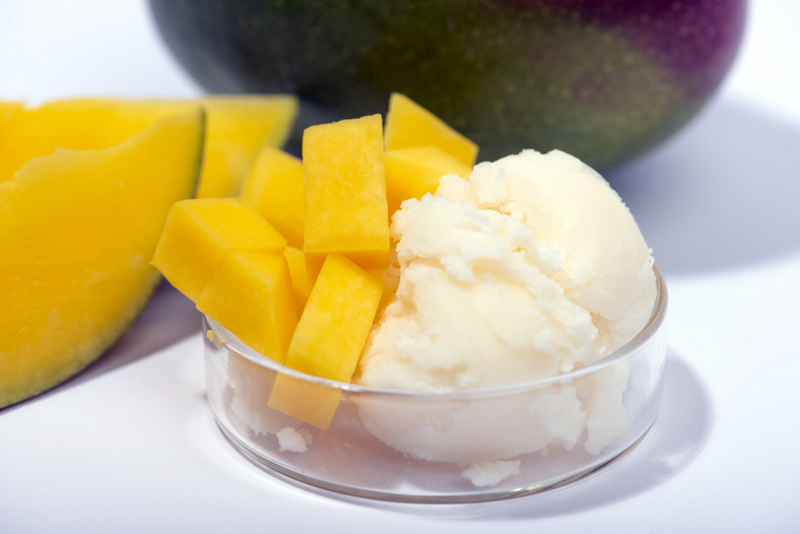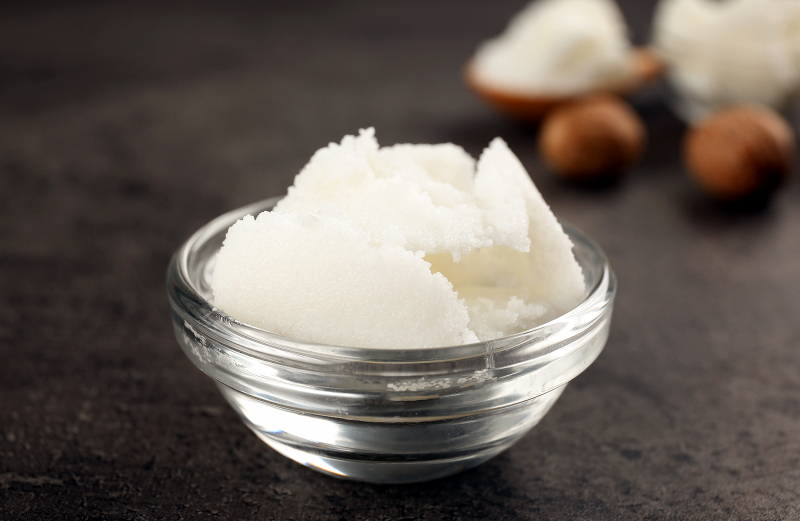Wondering which natural butter is best for your skin, hair or other parts?
Mango and shea butter are wonderful products, full of nutrients and goodness that have many great benefits for skin, hair and more. They make a great alternative to more traditional moisturizers and are great for hydrating and giving you glowing skin.
If you love using all natural ingredients on your body, you are no doubt considering using shea butter or mango. But which is best?
In this article, I take you through exactly what mango butter is and what shea butter is before giving you a full mango butter versus shea butter comparison and detailing which is best for skin, face and hair.
I also compare whipped mango and shea butter with cocoa butter, in case you are considering cocoa butter as well.
Let’s start!

What Is Mango Butter?
When I first heard of mango butter, I imagined an ice-cream-like mango substance. However, that’s not the case. Mango butter is actually made from the seeds within mangoes. In fact, it doesn’t taste or smell like mangoes.
The first step to making mango butter is to remove the mango fruit seed from its shell in the center of the mango. This can be done with a knife when it is wet. Peel off the outside of the seed and then let the seed dry.
To make unrefined mango butter, it should then be pressed flat. Any oil extracted is then heated so it boils until it gains a creamy texture. Any impurities are removed. It is then cooled until it forms a solid.
Mango butter is solid at room temperature and melts easily into the skin when applied. It is an off-white/pale yellow and has a slightly sweet and fatty smell (but it’s very subtle).
It’s also possible to make refined mango butter which uses chemical solvents to extract the oil and create the butter. This also removes much of the good nutrients in mango butter so the resultant product is not as useful. The color is whiter than unrefined mango butter.

What Is Shea Butter?
Shea butter comes from the fat extracted from shea seeds which are found inside fruit on shea trees. They are native to West Africa.
Of course, the process of creating shea butter is not as easy as just finding these seeds. They first need to be taken from the shells inside the fruit and dried out.
At this point, there are options for the next steps depending on whether you want to make refined or unrefined (raw) shea butter.
Refined shea butter is extracted and processed in factories using high heat and chemical solvents. This is the cheapest and easiest way to make shea butter, but it produces shea butter that is a white color, odorless and has lost most of its nutrients, so it’s not as great a product.
Making unrefined shea butter is more effort, but the result is a nutrient-rich butter perfect for skincare and other uses.
To make this by hand, the dried seeds are ground into powder. This powder is roasted and then ground up to form a viscous substance ready for the next steps.
It’s then kneaded while adding water before being whipped while adding more water.
This forces the oils to coagulate together on the surface with the water sinking below. The oils are taken out and boiled. This removes any remaining water and also forces the impurities to rise to the top where they can be removed.
Shea butter is left behind. Once it is strained, it’s left to cool and solidify.
At room temperature, shea butter is a thick cream like consistency and is solid. It’s an off-white or ivory color and has a smoky/nutty smell.
This unrefined butter is full of useful and nourishing nutrients.
Read more about the differences between refined and unrefined (or raw) shea butter here.

Mango Butter Vs Shea Butter
When it comes to a mango butter vs shea butter comparison, there are both similarities and differences between these two nutrient-rich butters. The exact winner of mango vs shea butter depends on what exactly you are looking for, but the reality is that you can somewhat use mango butter or shea butter interchangeably.
Mango butter is less used and researched than shea butter so it is a little less known, but it does seem to have many of the same great qualities.
Both shea and mango butter are solid, but soft and spreadable at room temperature. They melt on the skin and are easy to apply. They also mix with oils well.
They also both contain many nutrients, vitamins and useful fatty acids, like vitamins A and E both of which are antioxidants that promote blood circulation and regeneration of skin so they can both help with any age-related issues.
Both also have anti-inflammatory properties as well as antimicrobial properties. This means using shea or mango butter can help with wounds, soothing and reducing skin inflammation and fighting off skin infections.
Mango and shea butter both have the same three fatty acids as prime ingredients – linoleic, oleic and stearic acid. These can be quickly absorbed into the skin and can help with skin issues like rashes and peeling after sunburn. They all are moisturizing.
Both shea and mango butter are thought (but not proven) to be comedogenic which means they can clog pores making them not ideal for people with oily skin. Shea butter is probably better for oily skin of the two, however.
Difference Between Mango Butter And Shea Butter
One reason why you might prefer mango butter over shea butter is because it is basically odorless. Shea butter has a smoky and nutty smell that you may want to avoid. It is subtle though.
Mango butter has a lighter feel than shea butter and melts into the skin a little easier.
Where shea butter wins in a shea vs mango butter comparison is that it has more nutrients. Also, if you want to make a body butter, it whips better producing more body butter than the same amount of mango butter.
Shea butter also has a longer shelf life than mango butter lasting around two years, in general, with mango butter best used within 4-6 months.
While both can be good for sensitive skin, mango butter can be particularly good for sensitive skin.
Mango Butter Vs Shea Butter For Skin
The good news is that if you are wondering about mango butter vs shea butter for skin or mango butter vs shea butter for face, both are good! They have similar qualities and both work well for skin and face.
However, mango butter contains more fatty acids. This makes it a better moisturizer, particularly if you have dry skin. It can also be preferred as it has little odor.
If you have oily skin, shea butter is generally considered better that mango butter for this type. However, note that the jury is still out on whether either is good for oily skin as they may clog pores. Read more about this here.
Mango Butter Vs Shea Butter For Hair
Likewise, when it comes to shea butter vs mango butter for hair, both are great for your hair. Both have nutrients and vitamins which can help encourage healthy, shiny hair with less split ends.
Mango butter has an advantage as it doesn’t look as greasy in hair as shea butter. It also has a lower melting point so can be easier to apply to hair in cooler climates.
Even better is to make a combined mango shea butter and apply this to your hair, getting all the benefits of both.
Shea Butter Vs Cocoa Butter Vs Mango Butter
So we’ve talked a lot about shea and mango butter, but what if we widen our comparison to shea butter vs mango butter vs cocoa butter?
Cocoa butter is also often used somewhat interchangeably with these butters and is another good option for many things. Made from cocoa beans, it contains many of the same vitamins, nutrients and fatty acids.
It’s also very moisturizing and melts into the skin easily. It has a stronger smell than the other butters with a chocolate smell which can be a bonus or a negative depending on how you look at it. I find the scent can be over powering by itself.
It has a longer shelf life of 2-5 years. I personally love the feel of cocoa butter mixtures on my skin, especially lips.
Where cocoa butter loses out is that it clog pores, so isn’t recommend for oily skin at all. Like shea butter, it can also make your hair look greasier than mango butter.
Read our full comparison of cocoa butter and shea butter here.
Conclusion
I hope you found this guide to shea butter vs mango butter useful and now know the answer to is mango butter better than shea butter.
Both butters are great and there isn’t really a clear-cut winner. When deciding whether you want to use cocoa, shea or mango butter on your skin or other places, it’s all about personal preference.
I recommend you try both and see which you prefer. It’s hard to go wrong.
Find more useful guides to using shea butter here and an in depth guide to how to use shea butter on your feet here and on your lips here.


Comments are closed.